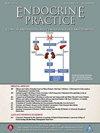Clinical Accuracy of Continuous Glucose Monitoring Immediately After Kidney Transplant in Patients With Type 2 Diabetes
IF 3.7
3区 医学
Q2 ENDOCRINOLOGY & METABOLISM
引用次数: 0
Abstract
Objective
To evaluate the accuracy of a blinded continuous glucose monitoring (CGM) device compared with point-of-care testing (POCT) and serum glucose measurements in the immediate postoperative period among kidney transplant recipients with type 2 diabetes mellitus (DM).
Methods
In this prospective study, we enrolled 22 participants aged ≥18 years, with type 2 DM, immediately after kidney transplant. We applied a blinded CGM device that sampled interstitial glucose every 15 minutes and collected POCT and serum glucose values. Using matched pairs of glucose readings between CGM and POCT and between CGM and serum glucose, we calculated bias and absolute relative difference and conducted a Clarke Error Grid Analysis.
Results
Eighty-two percent of the participants were male, with a mean age of 58 ± 9.69 years, mean body mass index of 30 ± 6.41 kg/m2, and baseline mean A1C level of 6.7 ± 1.07%. The mean durations of type 2 DM and end-stage kidney disease were 19 ± 10.6 and 3 ± 2.27 years, respectively. There were 327 and 72 matched pairs of CGM/POCT and CGM/serum glucose data, respectively. Clarke Error Grid Analysis comparing CGM/POCT showed 83.79% of values in zone A and 15.29% in zone B (combined 99.08%), with a mean absolute relative difference of 13.24%. For CGM/serum glucose, values of 83.1% were in zone A, and values of 16.9% were in zone B (combined 100%), with a mean absolute relative difference of 13.10%.
Conclusion
CGM provided accurate blood glucose measurements compared with POCT and serum glucose values in patients with type 2 DM after kidney transplant. When used in this patient population, CGM devices have the potential to improve clinical outcomes through earlier detection and intervention for glycemic excursions.
2型糖尿病患者肾移植后立即持续血糖监测的临床准确性。
目的:评价盲法连续血糖监测(CGM)装置与即时护理试验(POCT)和2型糖尿病肾移植受者术后立即血糖测量的准确性。方法:在这项前瞻性研究中,我们招募了22名年龄≥18岁的2型糖尿病患者,他们在肾移植后立即接受治疗。我们采用盲法CGM装置,每15分钟取样间质葡萄糖,并收集POCT和血清葡萄糖值。在CGM和POCT之间使用匹配的葡萄糖读数;在CGM和血糖之间,我们计算偏倚、绝对相对差,并进行Clarke误差网格分析。结果:参与者中82%为男性,平均年龄58±9.69岁,平均体重指数30±6.41 kg/m2,基线平均A1c 6.7±1.07%。2型糖尿病和终末期肾病的平均病程分别为19±10.6年和3±2.27年。CGM/POCT和CGM/血糖数据分别匹配327对和72对。比较CGM/POCT的Clarke Error Grid分析显示,A区83.79%,B区15.29%(合计99.08%),平均绝对相对差(Mean Absolute Relative Difference, MARD)为13.24%。CGM/血清葡萄糖在A区占83.1%,B区占16.9%(合并100%),MARD为13.10%。结论:与POCT和血清葡萄糖值相比,CGM为肾移植后2型糖尿病患者提供了准确的血糖测量。当在这一患者群体中使用时,CGM装置有可能通过早期检测和干预血糖升高来改善临床结果。
本文章由计算机程序翻译,如有差异,请以英文原文为准。
求助全文
约1分钟内获得全文
求助全文
来源期刊

Endocrine Practice
ENDOCRINOLOGY & METABOLISM-
CiteScore
7.60
自引率
2.40%
发文量
546
审稿时长
41 days
期刊介绍:
Endocrine Practice (ISSN: 1530-891X), a peer-reviewed journal published twelve times a year, is the official journal of the American Association of Clinical Endocrinologists (AACE). The primary mission of Endocrine Practice is to enhance the health care of patients with endocrine diseases through continuing education of practicing endocrinologists.
 求助内容:
求助内容: 应助结果提醒方式:
应助结果提醒方式:


